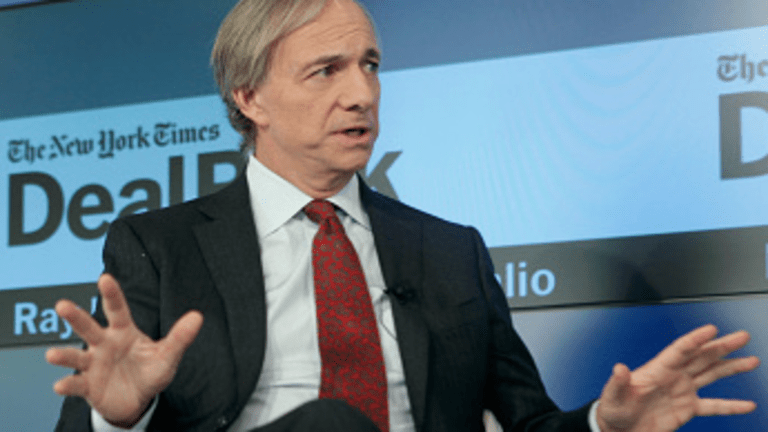Ray Dalio Fears “Scary Situation” For Global Economy Due To Fed Impotence, AI Adoption
Having warned in the past that central banks’ ability to reverse an economic downturn is coming to an end (just as the global economy enters what he says are the late stages of the long-term debt cycle), Billionaire hedge-fund founder Ray Dalio warned today that the global economy is under threat from an explosive mix of ineffective monetary policy, a rise in the wealth gap and climate change.
This combination, according to the Bridgewater Associates founder – the world’s largest hedge fund – will lead to a “scary situation” over the next decade…
“The technology and increasing use of artificial intelligence and increased productivity will also substantially increase the wealth gap, the job gap, the wealth and ideological conflicts within countries.”
Billionaire Ray Dalio says the global economy faces a ‘scary situation’ https://t.co/UQTmCDqrRu pic.twitter.com/NvBofCJEno
— Bloomberg Economics (@economics) October 29, 2019
This brief comment fits with Dalio’s previous warning that there are “three big forces” for investors to watch:
-
the point where there’s an economic downturn and central banks can’t cut interest rates further and their asset purchases cease being effective,
-
when rising inequality sparks “extreme” conflicts between the rich and poor,
-
and the battle for global dominion between the rising power of China and the incumbent world power, the US.
Concluding that if/when there is an economic downturn, that will produce serious problems in ways that are analogous to the ways that the confluence of those three influences produced serious problems in the late 1930s.
Regarding the above analog and where we are now, in my opinion, the most important things that are happening (which last happened in the late 1930s) are
a) we are approaching the ends of both the short-term and long-term debt cycles in the world’s three major reserve currencies, while
b) the debt and non-debt obligations (e.g. healthcare and pensions) that are coming at us are larger than the incomes that are required to fund them,
c) large wealth and political gaps are producing political conflicts within countries that are characterized by larger and more extreme levels of internal conflicts between the rich and the poor and between capitalists and socialists,
d) external politics is driven by the rising of an emerging power (China) to challenge the existing world power (the US), which is leading to a more extreme external conflict and will eventually lead to a change in the world order, and [Ian Bremmer calls this the return of a bi-polar world but with significant differences in the goals of the powers—JM]
e) the excess expected returns of bonds is compressing relative to the returns on the cash rates central banks are providing
As for monetary policy and fiscal policy responses, it seems to me that we are classically in the late stages of the long-term debt cycle when central banks’ power to ease in order to reverse an economic downturn is coming to an end because:
-
Monetary Policy 1 (i.e. the ability to lower interest rates) doesn’t work effectively because interest rates get so low that lowering them enough to stimulate growth doesn’t work well,
-
Monetary Policy 2 (i.e. printing money and buying financial assets) doesn’t work well because that doesn’t produce adequate credit in the real economy (as distinct from credit growth to leverage up investment assets), so there is “pushing on a string.” That creates the need for…
-
Monetary Policy 3 (large budget deficits and monetizing of them) which is problematic especially in this highly politicized and undisciplined environment.
More specifically, central bank policies will push short-term and long-term real and nominal interest rates very low and print money to buy financial assets because they will need to set short-term interest rates as low as possible due to the large debt and other obligations (e.g. pensions and healthcare obligations) that are coming due and because of weakness in the economy and low inflation.
Their hope will be that doing so will drive the expected returns of cash below the expected returns of bonds, but that won’t work well because:
a) these rates are too close to their floors,
b) there is a weakening in growth and inflation expectations which is also lowering the expected returns of equities,
c) real rates need to go very low because of the large debt and other obligations coming due, and
d) the purchases of financial assets by central banks stays in the hands of investors rather than trickles down to most of the economy (which worsens the wealth gap and the populist political responses).
This has happened at a time when investors have become increasingly leveraged long due to the low interest rates and their increased liquidity. As a result we see the market driving down short-term rates while central banks are also turning more toward long-term interest rate and yield curve controls, just as they did from the late 1930s through most of the 1940s.
Tyler Durden
Tue, 10/29/2019 – 13:25
via ZeroHedge News https://ift.tt/2Nl5ofT Tyler Durden
